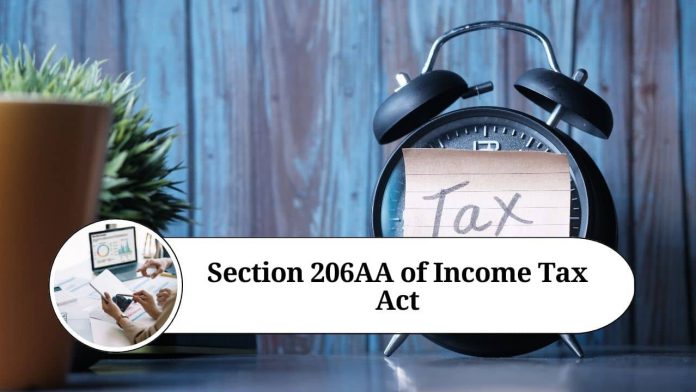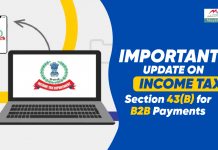Section 206AA of the Income Tax Act: An Overview
Section 206AA of the Income Tax Act was introduced to ensure that the tax deducted at source (TDS) is collected from non-resident taxpayers at a higher rate than what is normally applicable to residents. In this blog, we will discuss the key provisions of Section 206AA and their implications for taxpayers.
Who is a non-resident taxpayer?
A non-resident taxpayer is an individual who is not a resident of India for tax purposes. A person is considered a resident if they have spent more than 182 days in India in a financial year or 60 days in the previous year and 365 days in the preceding four years. Non-resident taxpayers may include foreign companies, individuals, and other entities that derive income from India.
Provisions of Section 206AA
The key provisions of Section 206AA are as follows:
Higher TDS rate for non-residents
Under Section 206AA, non-resident taxpayers are subject to a higher TDS rate than residents. The TDS rate for non-residents may be as high as 20%, depending on the nature of the income earned. This is done to ensure that non-residents do not escape tax liability in India.
Requirement of PAN
Section 206AA mandates that non-resident taxpayers must have a Permanent Account Number (PAN) to claim a lower TDS rate. If a non-resident taxpayer does not have a PAN, the TDS rate applicable to them will be the higher rate prescribed under the law.
Exception for certain categories of non-residents
Section 206AA provides an exception to certain categories of non-residents who are not required to obtain a PAN. These include non-residents who are covered under certain provisions of the Income Tax Act or who have obtained a Tax Identification Number (TIN) in their home country.
Implications for Taxpayers
Section 206AA has significant implications for non-resident taxpayers who derive income from India. They must obtain a PAN to claim a lower TDS rate, failing which they will be subject to a higher TDS rate. This can result in higher tax liability for non-resident taxpayers.
How to obtain a PAN for non-resident taxpayers?
Non-resident taxpayers can obtain a PAN by submitting a Form 49AA to the Income Tax Department. The form can be submitted online or through a physical application. Non-resident taxpayers must provide their name, address, date of birth, and other relevant details to obtain a PAN.
Non-resident taxpayers may face challenges in obtaining a PAN due to their non-resident status. They may need to appoint a representative in India to obtain a PAN on their behalf. Additionally, non-residents may face delays in obtaining a PAN, which can result in higher TDS rates being applied to their income.
Exceptions to Section 206AA
As mentioned earlier, certain categories of non-residents are exempt from the requirement of obtaining a PAN under Section 206AA. These include non-residents who are covered under certain provisions of the Income Tax Act or who have obtained a Tax Identification Number (TIN) in their home country.
For instance, non-resident taxpayers who are covered under the Double Taxation Avoidance Agreement (DTAA) between India and their home country are exempt from the requirement of obtaining a PAN. In such cases, the TDS rate applicable to them would be determined based on the provisions of the DTAA.
Effects of Section 206AA on foreign investment in India
The implementation of Section 206AA has had a significant impact on foreign investment in India. Non-resident taxpayers who invest in India now face a higher tax burden, which can make investing in India less attractive.
The higher TDS rate applicable to non-residents may result in reduced cash flows for foreign investors, which can impact their decision to invest in India. Additionally, the requirement of obtaining a PAN can add to the compliance burden of non-resident investors and increase the time and cost associated with investing in India.
However, it is important to note that the exemptions to Section 206AA, such as those provided under the DTAA, can help mitigate some of the tax burdens for foreign investors. These exemptions can help ensure that foreign investors are not subject to a higher TDS rate and can claim a lower rate based on the provisions of the DTAA.
Conclusion
Section 206AA of the Income Tax Act is an important provision that aims to ensure that non-resident taxpayers pay their fair share of taxes in India. While it has resulted in a higher tax burden for non-resident taxpayers, exemptions provided under the DTAA can help mitigate some of the tax burdens for foreign investors. Non-resident taxpayers investing in India must be aware of these provisions and exemptions to ensure that they are paying the correct amount of taxes in India. Additionally, the Indian government must continue to evaluate the impact of Section 206AA on foreign investment and take steps to ensure that India remains an attractive destination for foreign investment.
Read more useful content:
Frequently Asked Questions (FAQs)
- What is Section 206AA of the Income Tax Act?
Section 206AA is a provision of the Income Tax Act that mandates a higher rate of tax deduction at source (TDS) for non-resident taxpayers who do not have a Permanent Account Number (PAN) in India.
2. Who is a non-resident taxpayer?
A non-resident taxpayer is an individual or entity who is not a resident of India but earns income in India. This includes foreign companies, individuals, and other entities.
3. What is the higher TDS rate applicable to non-resident taxpayers under Section 206AA?
The higher TDS rate applicable to non-resident taxpayers under Section 206AA is the higher of the following rates: the rate specified in the relevant tax treaty between India and the non-resident’s home country or 20%.
4. Is obtaining a PAN mandatory for non-resident taxpayers?
Obtaining a PAN is mandatory for non-resident taxpayers who wish to claim a lower TDS rate than the rate specified under Section 206AA. Non-resident taxpayers who do not obtain a PAN are subject to a higher TDS rate.
5. How can non-resident taxpayers obtain a PAN?
Non-resident taxpayers can obtain a PAN by submitting a Form 49AA to the Income Tax Department. The form can be submitted online or through a physical application.
6. Are there any exemptions to Section 206AA?
Yes, there are exemptions to Section 206AA. Non-resident taxpayers who are covered under certain provisions of the Income Tax Act or who have obtained a Tax Identification Number (TIN) in their home country may be exempt from the requirement of obtaining a PAN.
7. What is the Double Taxation Avoidance Agreement (DTAA)?
The Double Taxation Avoidance Agreement (DTAA) is a treaty signed between India and other countries to avoid double taxation of income earned by individuals and entities in both countries.
8. Are non-resident taxpayers covered under the DTAA exempt from Section 206AA?
Non-resident taxpayers who are covered under the DTAA may be exempt from the requirement of obtaining a PAN under Section 206AA. In such cases, the TDS rate applicable to them would be determined based on the provisions of the DTAA.
9. What is the impact of Section 206AA on foreign investment in India?
Section 206AA has had a significant impact on foreign investment in India as non-resident taxpayers now face a higher tax burden, which can make investing in India less attractive. However, exemptions provided under the DTAA can help mitigate some of the tax burdens for foreign investors.
10. How can non-resident taxpayers ensure compliance with Section 206AA?
Non-resident taxpayers can ensure compliance with Section 206AA by obtaining a PAN in a timely manner and being aware of the exemptions provided under the DTAA. They must also ensure that they are paying the correct amount of taxes in India to avoid any tax liability issues.




















